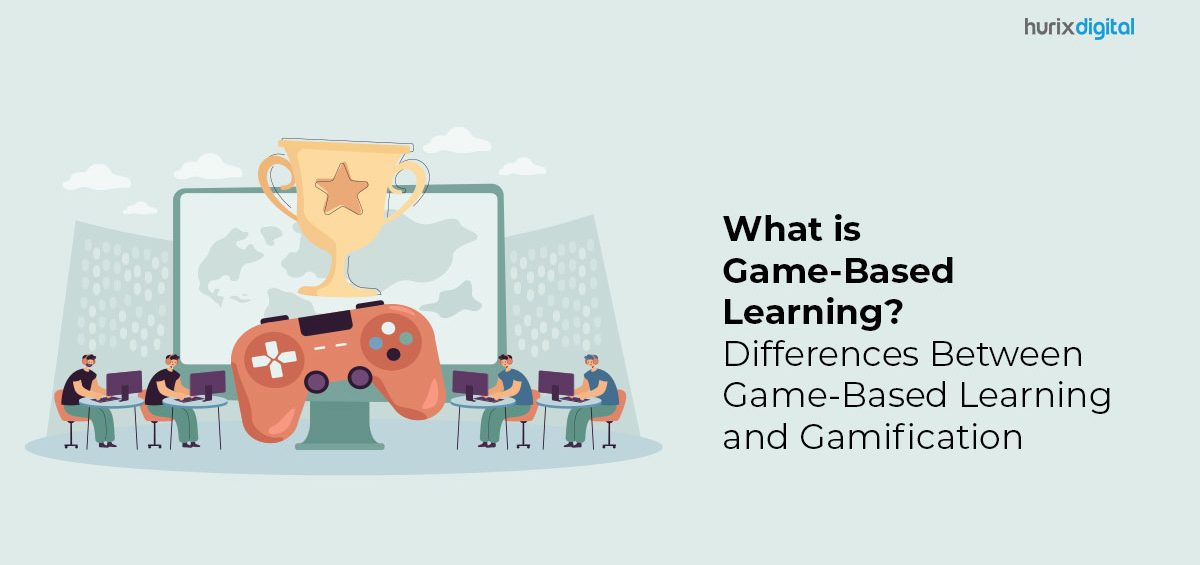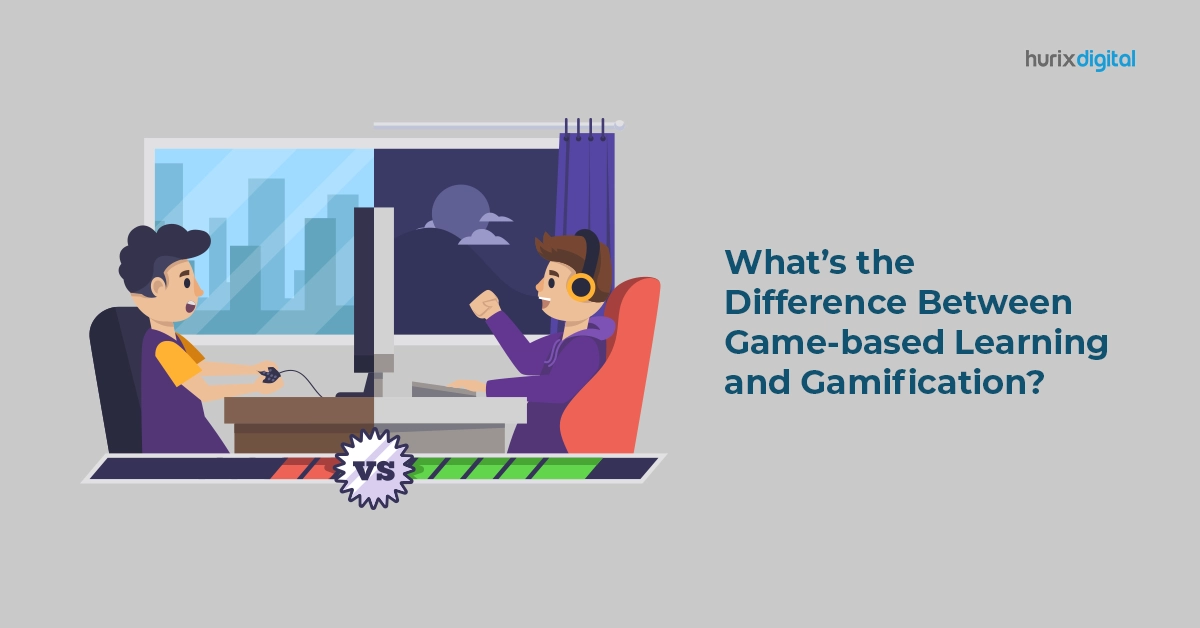Summary
This article provides a brief overview of the differences between game-based learning and gamification. It also provides a summary of the key characteristics of both game-based learning and gamification.
The terms gamification and game-based learning are occasionally used interchangeably. However, the terms technically do not mean the same thing. Instead, although they are both increasingly popular approaches to education, they differ in a few subtle, yet significant ways. Here is a deep dive into the differences between game-based learning and gamification.
Table of Contents:
- Traits Game-Based Learning and Gamification in Education Share
- What is Game-Based Learning?
- What is Gamification in Education?
- Is Game-Based Education Here to Stay?
- Game-Based Learning Solutions from Hurix Digital
Traits Game-Based Learning and Gamification in Education Share
Game-based learning and gamification in education share several key characteristics.
Firstly, both approaches are designed to engage learners through the addition of fun. Whether a student is involved in game-based learning solutions such as online math games or becomes engaged by dressing up as their favorite historical figure to engage in debates about a variety of viewpoints, both game-based learning and gamified learning engage students.
Both approaches are also designed to motivate students. Consider, for example, students competing in a spelling bee. A spelling bee is a clear example of how gamification in education can motivate students to study diligently, learn to control anxiousness, and feel confident in the spotlight, in addition to learning excellent spelling skills. Similarly, the desire to earn a position on a game or classroom leaderboard, or to progress to the next level of an educational video game can also motivate students.
What is Game-Based Learning?
Game-based learning has earned a lot of raving fans, in large part because it can be used in all K12 levels. Moreover, game-based learning solutions are available to provide instruction on virtually all subjects, ranging from English to STEM subjects. Game-based learning in education uses a game (often educational video games) as the primary instructional tool for specific subject matter.
Game-based learning is an educational approach that blends game elements into learning. Game-based learning is used in both educational technology (digital, such as online games) and traditional educational instruction (non-digital, such as board games).
Effective game-based learning tools require experts in the fields of education, research, and game design, to come together to create the products that will achieve the desired results.
Game-based learning has risen to the forefront of education in the 21st Century, but as an approach to teaching, it has been in use for thousands of years.
Researchers cite the benefits of game-based learning which include:
1. Safe Space for Experimentation and Exploration
When playing game-based learning tools, students can try different solutions to problems. Educational video games therefore encourage practice, without risk.
2. Offering Contextualized Learning Opportunities
Educational technology that allows for game-based e-learning may be superior to other educational approaches in terms of offering contextualized learning opportunities. For example, consider that reading about a historical event is a form of passive learning. By contrast, an educational video game may have the student play as the historical character, and make choices that consider the world at that time (active learning).
3. Development of Critical Thinking Skills
Educational video games allow students to think creatively about finding solutions to problems, by offering various choices in games that will lead to different outcomes. This allows for reflection on why a particular choice was incorrect, and why another choice was correct.
4. Immediate Feedback
Game-based learning tools, including educational video games, provide immediate feedback to the student. This allows students to adjust their understanding and knowledge immediately. Students can self-correct in real-time, thereby learning from their mistakes.
5. Bolstering Collaboration Skills
Game-based e-learning can help students to develop collaborative skills that will serve them beyond the classroom. Whether the students must work as a team to defeat the game, or another team, or if the students need to learn to barter with other players to succeed, games help to promote collaborative skills.
What is Gamification in Education?
Gamification in education is the application of game elements into a non-game context. In other words, educators may create games as part of oral instruction, written instruction, etc. Games are not the primary instructional tool. Instead, they are one tool educators use to challenge, motivate, and inspire students.
Examples of gamification in learning include:
- Timed challenges
- Timed tests
- Classroom leaderboards
- Points and award-based incentives (stickers, badges, etc.)
- Judged contests, debates
- Competitive challenges (spelling bee, geography bee, etc.)
Gamified learning offers similar benefits to game-based learning:
1. Enhanced Engagement
Gamified learning often improves student engagement. Students like it for a variety of reasons, including the competitive nature of games, the potential for rewards, or the earning of recognition.
2. Greater Understanding and Retention
When learning is fun, students tend to learn more deeply. This promotes a deeper understanding and retention of the material learned.
3. Learning Becomes Active
Gamified learning transitions students from a passive learning method (reading a textbook or listening) to an active learner (competitor in game-based learning solutions). Both active and passive learning are essential for student development.
4. Promotes Critical Thinking and Analysis
When subject matter is supplemented with game elements, students are often required to use critical thinking, decision-making, and problem-solving skills that other instructional methods do not require.
5. FostersTeamwork
The gamification of learning helps to boost teamwork, and team-building among students, as group activities and efforts help to build bonds and cohesiveness amongst players on the same team.
Is Game-Based Education Here to Stay?
By all indications, gamified learning, specifically through the use of game-based learning solutions, will play a significant role in the future of education. As technology advances at the fastest pace in human history, educators are likely to embrace game-based e-learning, to ensure students are equipped for a highly digitized world beyond primary and secondary education.
In addition to offering an engaging learning experience, the data-driven insights educators can glean in just seconds are unmatched by traditional methods. Educators can immediately identify students who are struggling, and students who are not being challenged enough. Moreover, adding educational technology to the repertoire of tools educators rely on, may reach students who struggle to engage with learning via traditional educational approaches. However, it is unlikely that game-based learning will replace traditional instruction for students in the foreseeable future.
Also Read: How to Use Educational Games to Promote Social-Emotional Learning in the Classroom
Game-Based Learning Solutions from Hurix Digital
Game Learning, a leading EdTech company, has partnered with Hurix Digital, one of the world’s leading digital curriculum providers to offer game-based learning solutions for the K12 curriculum. To learn more, or to request a free demo, contact Hurix Digital today.











